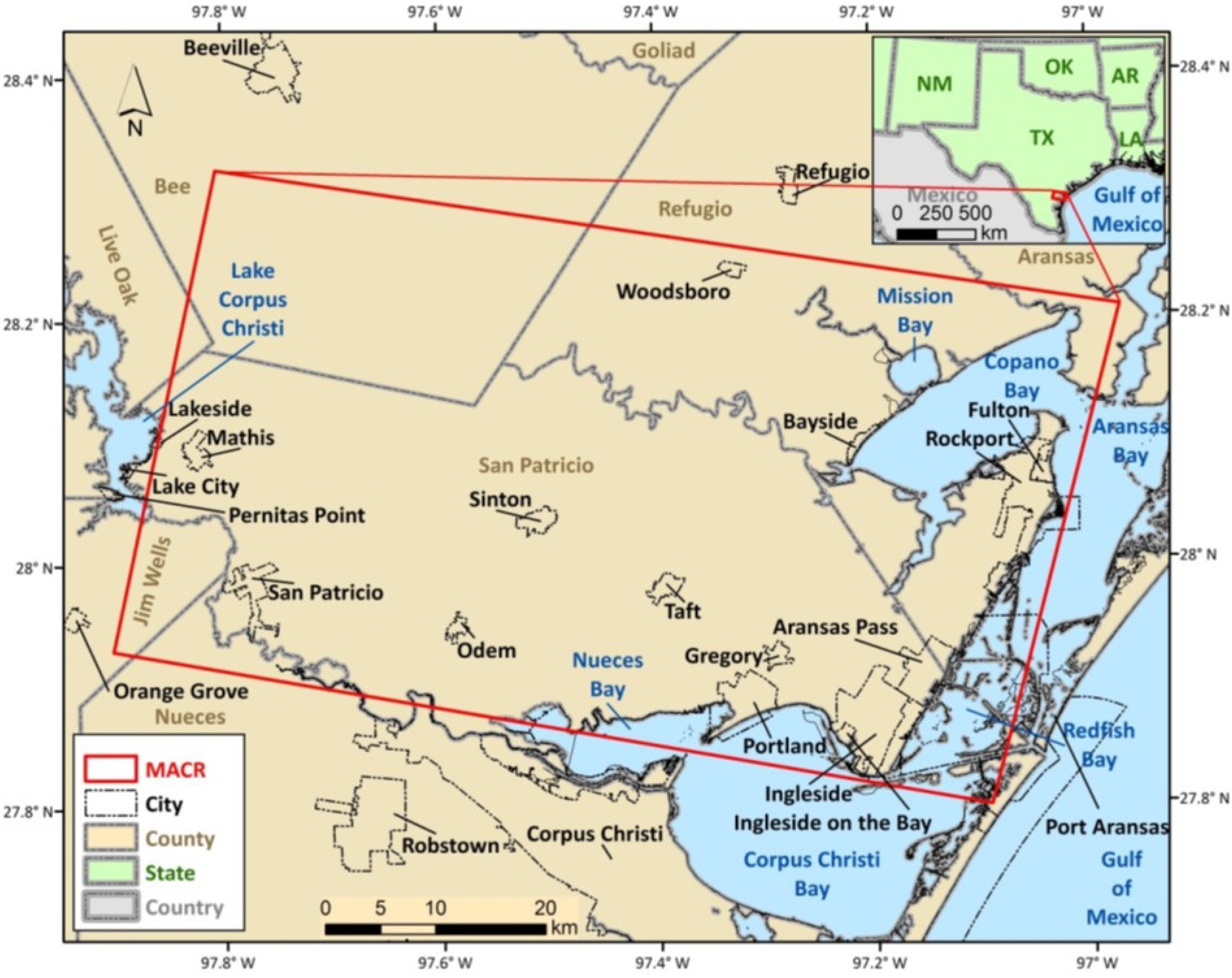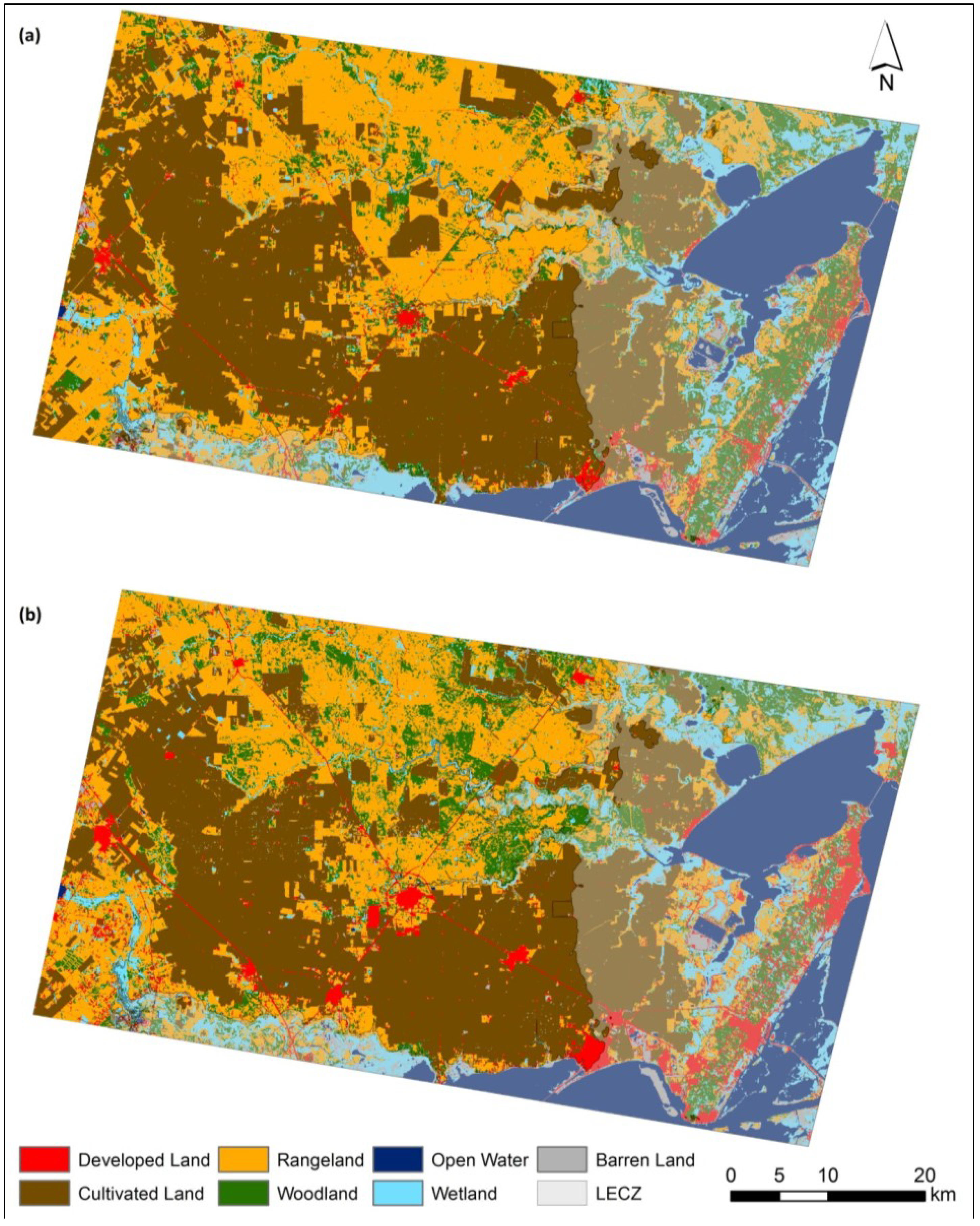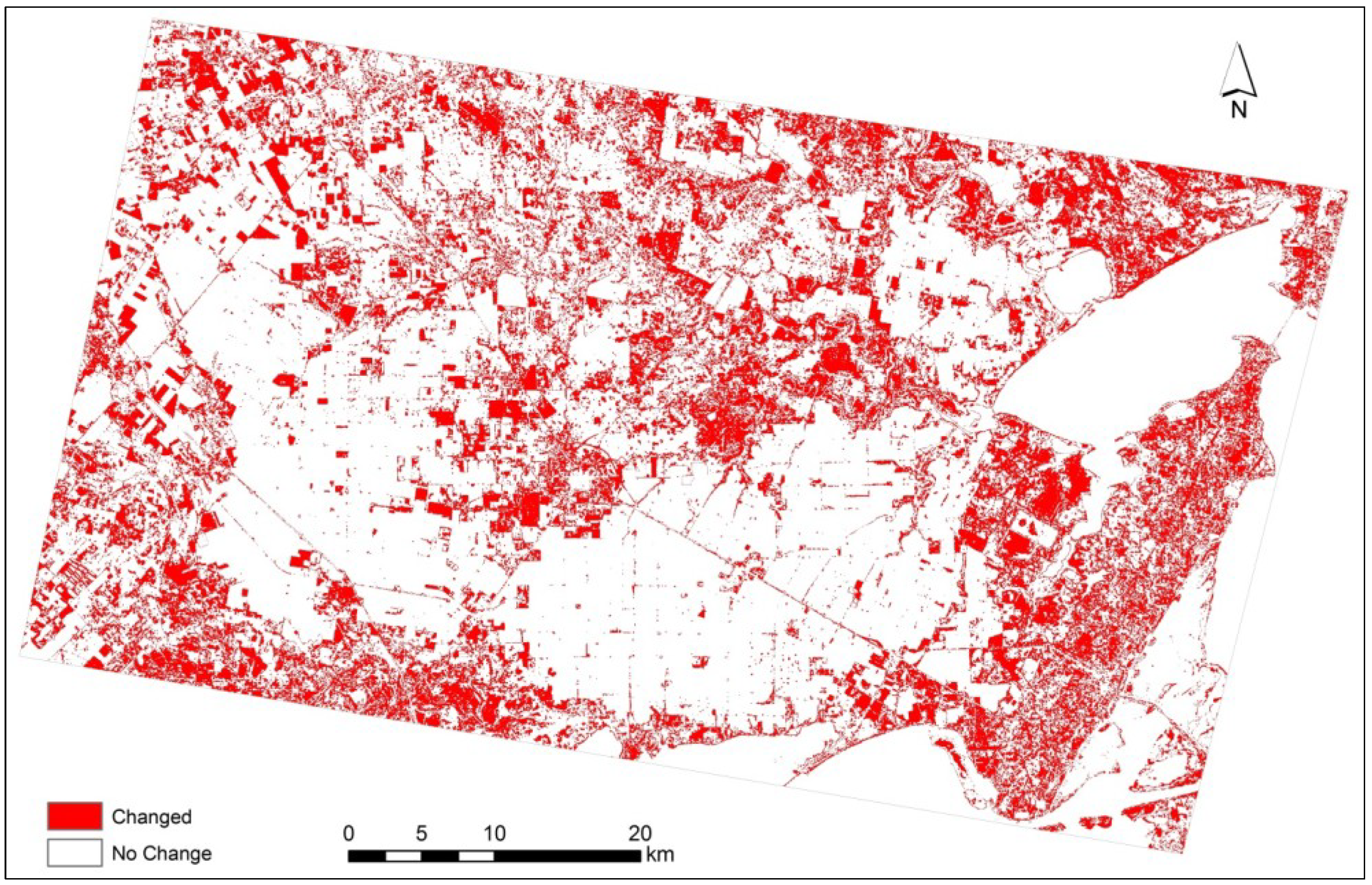1. Introduction
The change in land-use and land-cover (LULC), or more succinctly land change, is an integral component of global environmental change; hence, it is also a significant phenomenon to consider in moving towards global sustainability [
1,
2]. The transformation of land by human activities can disrupt biogeochemical cycles [
3,
4,
5] and influence the vulnerability of people and infrastructure to various natural hazards [
6,
7,
8]. LULC changes can alter the quantity and quality of freshwater resources [
9,
10,
11], increase the potential for soil erosion [
12,
13], and lead to habitat loss and degradation [
14,
15].
In Texas, bays and estuaries are vital resources because these areas provide habitat for several fish and bird species of commercial and recreational value. A quarter of the state’s population resides in and a third of the state’s GDP comes from its estuary regions [
16]. The state comes in fifth place in 24 coastal U.S. states in terms of participation rate in marine recreation [
17]. However, the land changes in drainage basins upstream from these coastal areas can adversely affect these habitats due primarily to changes in water, sediment, and nutrient flows [
18,
19]. For example, the majority of nutrient loading to Texas estuaries arrive through freshwater inflows [
20]. Moreover, as in other states along the Gulf of Mexico, Texas lost over half of its original wetland area by the 1980s (estimated to be 64,700 km
2 circa 1780s) [
21]. Increasing development, as well as tropical storms and changes in the geometry of coastlines due to sea-level rise and subsidence contribute to the loss and degradation of the state’s coastal wetlands [
22,
23]. In particular, urbanization along the coasts takes place mostly at the expense of agricultural lands and rangelands but it also puts under stress the already-diminished natural areas, some of which harbor remarkable biodiversity [
24].
The combined impacts of sea-level rise, more-extreme precipitation, and tropical storm events due to anticipated climate change may lead to increased flooding along the Texas coastal region in the near future [
25]. In addition, with the ongoing coastal development, the exposure and vulnerability of the people and infrastructure in the region to such hazards would increase. Exposure refers to the presence of people, infrastructure or other assets in an area where hazard events may occur [
26]. Vulnerability is defined as the predisposition of people, infrastructure or other assets that are exposed to a certain hazard to be adversely affected by that hazard should it come to pass [
26].
The Mission-Aransas coastal region (MACR) on the Coastal Bend of Texas is an area with a complex mix of different land uses including wetlands, woodlands, agricultural fields, and urban land [
27]. The bays and estuaries in the Mission-Aransas region are especially sensitive to changes in land use/land cover (LULC) within the drainage basins upstream; these LULC changes can disrupt inputs of freshwater and material that are vital in maintaining salinity gradients, sedimentation rates, and nutrient cycles within the system [
28]. These coastal areas are also sensitive to population increase, development, and change in agricultural activities within the watershed upstream. For these reasons, one of the National Estuarine Research Reserve (NERR) sites across the U.S., Mission-Aransas NERR, is established in this region [
27,
29]. The NERR System, supported through the National Oceanic and Atmospheric Administration (NOAA), is a network of 28 protected estuarine sites in the US and Puerto Rico [
30]. One of the guiding principles of the NERR System is integrating “science, education and stewardship on relevant topics to maximize the benefits to coastal management” [
31]. In addition, “understanding the long term effects of climate-change related processes on the estuary, including global warming, sea level rise, increased frequencies of tropical storms…” and “understanding the impact of future population increases and urbanization of the watershed and estuary” are two of the stated priority research issues within the Mission-Aransas NERR [
29].
In this study, in line with the priorities of the Mission-Aransas NERR, we analyze the land changes in the MACR between 1990–2010 and the implications of these changes for the coastal vulnerability and the protected areas in the region. Specifically, we ask three questions:
- (1).
What are the most prominent land changes that took place in the MACR?
- (2).
How did the exposure of the built environment along the coast in the MACR to coastal hazards change?
- (3).
Has there been an increase in the amount of urban land around the protected areas?
2. Study Area
The Mission-Aransas coastal region (MACR) has an area of 3744 km
2 (
Figure 1). This area is approximately 30 miles north from the major urban center of Corpus Christi. Elevation in the region ranges from zero to 74 meters above sea level with most relief occurring in the northwestern portions. The MACR has a semi-arid climate with mean annual precipitation of 864 mm and a mean temperature of 21.8 °C. However, the distribution of annual precipitation is skewed by seasonal tropical storms that occasionally bring large amounts of rainfall [
32]. Most of the MACR falls within the Aransas Watershed, but it also includes portions of the Mission and Nueces watersheds. The eastern portions of the MACR are characterized by coastal/near-shore environments that include all of Copano and Mission bays, as well as portions of Aransas, Nueces, Corpus Christi, and Red Fish bays (
Figure 1). Central portions are mostly dominated by cultivated land with rangeland and woodland occupying much of the northern portions of the region [
33].
Figure 1.
Location map of the Mission-Aransas coastal region (MACR).
Figure 1.
Location map of the Mission-Aransas coastal region (MACR).
The MACR is predominantly rural with no large urban centers [
33] (
Table 1). Cities and towns are generally situated near the coast or streams; Portland, Ingleside, Rockport, and Aransas Pass are the largest urban areas (
Table 1). The main industries consist of oil and gas activities, recreational and commercial fishing, ground and surface water withdrawal, tourism, and shipping [
34]. The region is mostly at low elevation and its coastal areas face increasing risks from coastal hazards due to sea-level rise [
35]. The mean sea level rise was recorded as 5.16 mm/yr from 1948 to 2006 at Rockport [
36]. The current rate of sea level rise at Rockport is 5.50 mm/yr [
37].
There are a number of protected areas in and around the study area. These areas are set aside for biodiversity conservation and they are especially concentrated near the coastline. The most important protected area in the region is the Mission-Aransas NERR, which is home to several endangered species including the iconic whooping crane (
Grus americana) [
38]. Since its establishment over four decades ago, the NERR System has collected a large amount of data on the socioeconomic and biophysical characteristics of their respective estuarine and coastal environments, valuable in addressing several resource-management issues [
39]. Lately, the most significant issue facing NERR sites are impacts of land use and population growth [
31]. Land change within NERR sites affect not only the hydrology but also the water quality within these sites [
39].
Table 1.
Settlements that fall within the Mission-Aransas Coastal Region (MACR) along with their population in 2010.
Table 1.
Settlements that fall within the Mission-Aransas Coastal Region (MACR) along with their population in 2010.
| Name | County | Designation | Population in 2010 |
|---|
| Portland | San Patricio | City | 15,099 |
| Ingleside | San Patricio | City | 9387 |
| Rockport | Aransas | City | 8766 |
| Aransas Pass | Nueces/Aransas | City | 8204 |
| Sinton | San Patricio | City | 5665 |
| Mathis | San Patricio | City | 4942 |
| Taft | San Patricio | City | 3048 |
| Odem | San Patricio | City | 2389 |
| Gregory | San Patricio | City | 1907 |
| Woodsboro | Refugio | Town | 1512 |
| Fulton | Aransas | Town | 1358 |
| Ingleside on the Bay | San Patricio | City | 615 |
| San Patricio | San Patricio | City | 395 |
| Bayside | Refugio | Town | 325 |
| Total Urban Population | | | 63,612 |
5. Discussion
The MACR has no large urban centers, and it has a relatively sparse population. Nevertheless, anthropogenic activity has greatly influenced the biophysical characteristics of the landscape. A quarter of the study area underwent land change over the two-decade period. In particular, although it represents a modest proportion of the total area within MACR, the developed land nevertheless increased significantly. From 1990 to 2010, the developed land increased 71%, from 118 km
2 to 203 km
2 (
Table 9). Over the same period, however, the population in the study area increased 14.5% [
58].
The flat and low-lying Texas coastal plain has one of the highest rates of subsidence in the world [
59] due to a combination of tectonics and anthropogenic activities [
60]. Moreover, the potential increase in the frequency of storm surges elevates the risk of coastal flooding in the state [
35] with detrimental effects on settlements, infrastructure, and habitats. While the frequency of tropical storms has remained fairly constant over time, their potential destructiveness has increased over the recent past and may continue to do so [
61].
Our findings suggest a slightly higher rate of urban expansion in those lands that are deemed to be the most exposed to coastal hazards compared to more inland portions of the MACR. Much of this growth occurred in Rockport-Fulton and Aransas Pass on the Live Oak Peninsula (
Figure 1 and
Figure 2), which are already highly urbanized and have the highest population densities across the MACR. The low-elevation coastal zone (LECZ) defines, in approximate terms, the regions that are particularly exposed to the direct effects of sea level rise and storm surges as well as their potential indirect effects such as saline intrusion into groundwater aquifers [
8,
53]. The increasing concentration of infrastructure and people in these coastal areas oftentimes means potentially large losses of life as well as monetary losses in the case of a storm surge or coastal flooding. This is especially evident in mega-deltas of Asia such as the Mekong Delta [
62] and Ganges-Brahmaputra [
63]. Cultivated lands can also be adversely affected from storm surges and sea level rise both directly and indirectly through saline water intrusion [
8,
64]. We find that about one-fifth of all cultivated lands in the MACR remain within the LECZ and are hence exposed to coastal hazards.
Sediment flow, important in sustaining deltas and wetlands, has been altered by human activities across the world [
65]. The decrease in its supply by rivers is also significantly impacting Texas coasts [
66]. Indeed, in the MACR, this is one of the major factors that is thought to affect the habitat quality within the Mission-Aransas NERR protected area [
28]. Continuing urbanization in the upper basins may initially lead to an increase in sediment supply but eventually lead to a sediment flow that is lower than that prior to urbanization [
67]. Our findings reveal that the increase in the developed land in the upper basin has been marked and suggest that this trend may continue into the future with potentially adverse impacts on the biodiversity within the protected area. The decrease in sediment flow also increases the risk of coastal erosion, which can lead to the loss of the coastal and estuarine habitats as well as the increased exposure of the urban areas to coastal hazards.
A recent global study reported that the most urban land in the year 2000 near protected areas was in North America [
68]. The MACR fits this pattern; almost all urban land in the region is within 50 km of the protected areas of the region, which were mostly established for conserving the regional biodiversity. The regulations that are in place minimize anthropogenic activities within the protected areas, such as the Aransas National Wildlife Refuge (ANWR), which is partly included within the Mission-Aransas NERR site. Nevertheless, those that occur near protected areas can still negatively impact these areas [
56]. The ANWR is one of the areas in the region that harbor critical habitats of the endangered whooping cranes (
Grus americana) [
27].
In many parts of the world, socio-economic changes, in particular urbanization, appear to play a larger role in increasing exposure and vulnerability than anticipated increases in frequency and magnitude of extreme events due to climate change [
69,
70,
71]. In Texas, the problems facing estuaries along the Gulf coast such as pollution and decrease in freshwater inflow due to population and development pressure extends back to at least the 1970s [
72]. Likewise, the combined effects of socio-economic and biophysical changes increase the vulnerability of this region to coastal hazards in the MACR. A recent study identified populations in the MACR and its surrounding region as having high social vulnerability [
73], which means these communities may bear disproportionate costs of adaptation to coastal hazards.
The increasing extent of impervious surfaces that typically characterize urban land may lower infiltration capacity of the land and thus decrease groundwater recharge. Therefore, the major concern with the development in the study area is its disruption of the hydrologic cycle via decreased infiltration and alteration of seasonal river flow patterns. In addition, urban and agricultural areas are often major sources of elevated nutrient levels in streams that reach coastal and estuarine habitats [
74,
75] with adverse effects on the biodiversity [
75,
76]. Elevated nutrient concentrations can have adverse effects on the biodiversity in these habitats. Moreover, the shoreline in the region is already experiencing shoreline retreat due mainly to insufficient supply of sediment to counter the erosion caused by storms, sea-level rise, and development [
77]. Into the future, these issues are likely to be intensified as the effects of climate change become more apparent along the Texas coast in the form of sea-level rise [
25]. However, the adaptation planning remains inadequate in the state where sea-level rise is rarely considered in decisions about coastal development [
78]. One rare exception is the statewide Coastal Texas 2020 initiative, which aims to unite local, state, and federal efforts to promote the economic and environmental health of the Texas Coast [
79]. Another is the research and community outreach efforts in and around the Mission-Aransas NERR site [
29,
80]. Nevertheless, the existing regulatory environment in the state risks large losses of life, property, and infrastructure in the face of anticipated increases in sea level [
81].
A critical gap in our understanding is the interaction of land change with climate change and how this interaction impacts the sediment, nutrient, and freshwater flows in regions that are exposed to coastal hazards [
64]. Closing this gap is important to ensure suitable habitat quality for the biodiversity in these regions, but is also important to improve the socio-economic conditions. Our findings provide important insights into the growing exposure and vulnerability of the urban areas in the MACR and of the Mission-Aransas NERR to coastal flooding due to land change and sea level rise. Quantifying and mapping LULC change in the region is the first step to accurately model the interaction of land cover and hydrological, sediment, and nutrient flows into the fragile ecosystems of the Mission-Aransas NERR site. Specifically, the LULC data outputs generated in this analysis can inform hydrological modeling of the MACR region to more accurately evaluate flooding risk as well as analyze changes in water quality due to the LULC change. Analyses of land changes such as this one can also inform land and other resource management decisions within the greater Mission-Aransas and Nueces region [
82].
6. Conclusions
In this study, we examine the land-use/land-cover changes within the Mission-Aransas coastal region (MACR) on the Coastal Bend of Texas over the period of 1990–2010. Specifically, we determine the prominent land-change patterns and the implications of these patterns on the vulnerability of the urban residents and infrastructure to coastal hazards, and conservation of biodiversity in the MACR.
Our findings show that the MACR experienced a significant amount of LULC change over the last two decades. The MACR has been undergoing high rates of expansion of developed land. This growth may have increased the vulnerability of the urban residents and infrastructure to coastal hazards in the region. It has also meant more development in the vicinity of the protected areas such as the Aransas National Wildlife Refuge.
These trends are in line with global trends in urbanization, and each has significant implications for climate-change adaptation and biodiversity conservation in the region. The findings from this study also provide valuable input in determining the response of fluvial and coastal geomorphic systems to land change. Such analyses can help stakeholders develop more informed strategies for sustainable management of the Mission-Aransas NERR and its surroundings.








